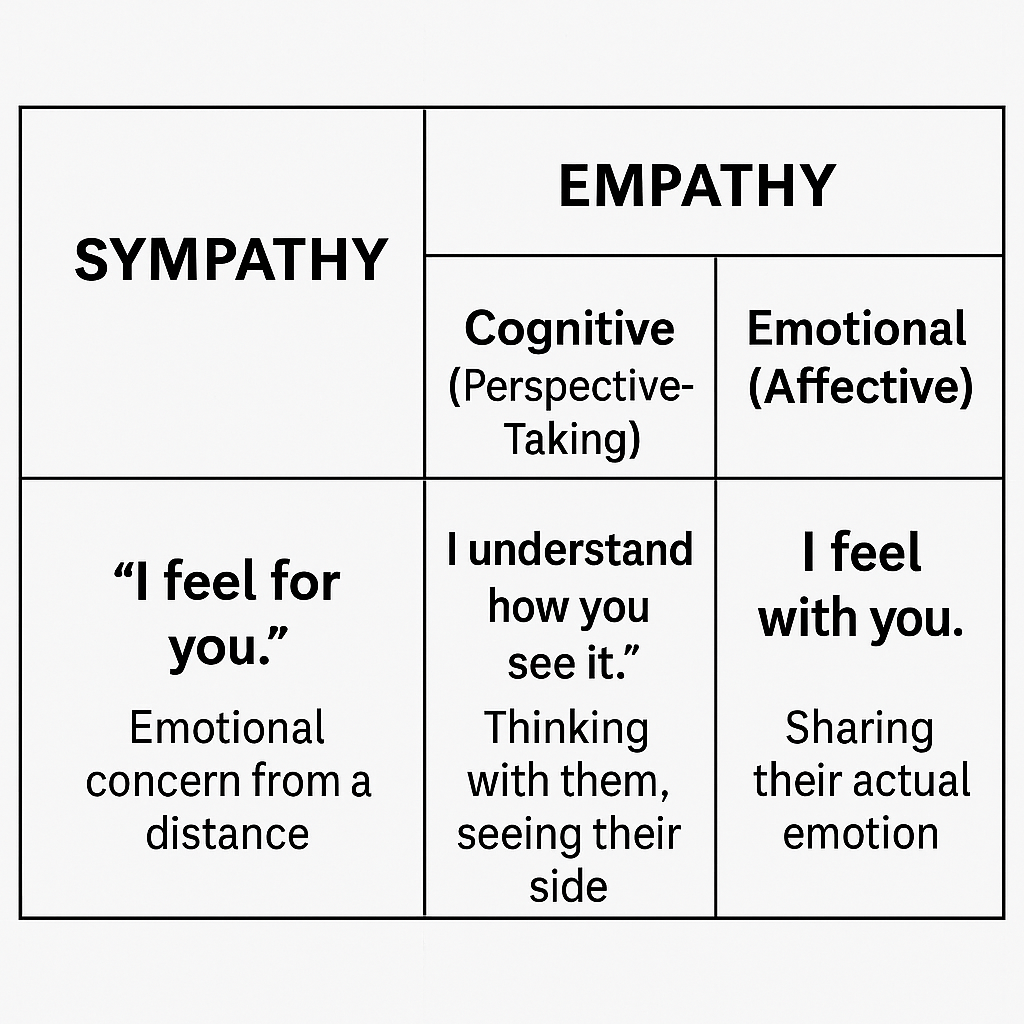Perspective-Taking vs Empathy in Negotiation:
What Negotiators Need to Know

In many negotiation training programs, empathy is often listed as a must-have skill. It’s praised as a way to build trust, defuse tension, and create a foundation for meaningful agreement. And that’s all true -as long as we’re clear on what kind of empathy we’re talking about.
Too often, negotiators and trainers use the word “empathy” without defining it. This results in people often confusing empathy with sympathy, or overusing emotional tactics that can actually hurt their outcomes. So let’s unpack what empathy really means, where it helps, and when to be careful.
Whether you’re training to become a mediator, advancing your negotiation skills, or just trying to navigate high-stakes decisions more effectively, understanding this distinction is essential.
What Is Empathy and Why Is It Used in Negotiation?
At its core, empathy in negotiation is about understanding and connecting with the other person. It helps you anticipate their reactions, respond to their concerns, and frame proposals that actually land.
But beyond strategy, empathy also helps build trust and rapport -something especially crucial in emotionally charged or high-stakes conversations. In settings like crisis negotiation or mediation, establishing a human connection can shift the dynamic from confrontation to cooperation.
That said, empathy isn’t just one thing. Psychologists typically divide it into two distinct forms:
- Cognitive empathy – also known as perspective-taking. This is the ability to understand how the other person sees things – what they want, what they fear, and how they’re making sense of the conversation.
- Emotional empathy – also called affective empathy. This is the ability to feel with someone -emotionally resonating with their frustration, sadness, or anxiety.
In negotiation, this distinction becomes crucial – because each type plays a different role, and they don’t always lead to the same outcomes.
Why Perspective-Taking Is More Effective Than Emotional Empathy
In a landmark study published in Psychological Science, Galinsky, Maddux, Gilin, and White (2008) compared the effects of perspective-taking (cognitive empathy) and emotional empathy in negotiation.
Their finding?
Perspective-taking consistently led to better results.
Negotiators who focused on understanding the other party’s point of view were better at:
- Identifying creative solutions,
- Claiming value,
- And navigating toward agreements that satisfied both sides.
On the other hand, negotiators who focused on emotional empathy -those who felt with the other party- were more likely to make unnecessary concessions. They got emotionally swept up in the dynamic and gave away more than they needed to.
So while empathy builds connection, too much emotional empathy can cloud your judgement.
From Understanding to Connection: Using Empathy Without Overextending
It’s clear that cognitive empathy -the ability to see the situation from the other person’s perspective- is the most effective form of empathy in negotiation.
But understanding alone isn’t enough. You also need to show that you understand. That’s what builds trust and connection without sacrificing strategic footing, and it’s where active listening comes in.
At the same time, it’s worth noting that emotional empathy isn’t inherently bad. In mediation or relationship-based conflict resolution, being able to emotionally connect can be valuable. If you’re working to repair trust, rebuild connection, or coach others through relational tension, emotional empathy can support healing and humanization.
But in more adversarial or high-stakes negotiations, emotional empathy should be used with care. Feeling too much with the other party can undermine your judgement or lead to concessions that aren’t in your best interest.
How Active Listening Helps Negotiators Show Empathy Strategically
Active listening is a core skill taught in most negotiation training programs -and for good reason. It’s how we signal empathy without losing perspective.
For example:
- “It sounds like fairness is your top concern.”
- “You’ve been navigating a lot of pressure, and it feels like your input isn’t being heard.”
These kinds of responses acknowledge the other party’s experience without requiring you to absorb their emotion. It builds connection, but keeps you grounded.
Sympathy in Negotiation: Helpful or Harmful?
Sympathy is different again. It’s more like:
“I feel bad for you.”
There’s a sense of care, or even pity, but from a distance. Sympathy doesn’t always involve understanding the other person’s mindset, nor does it require emotional resonance.
In negotiation, sympathy can be a double-edged sword. It might come off as dismissive or condescending, especially if the other party feels like you’re not truly engaging with them. It also doesn’t give you any strategic insight -you may feel sorry, but you won’t know what to do about it.
So while sympathy has a place in broader interactions, it’s rarely a reliable negotiation strategy.
Key Takeaways for Negotiators and Conflict Resolution Professionals
Whether you’re negotiating a high-stakes deal, managing workplace tension, or guiding others through conflict, understanding this distinction matters.
- Rely on cognitive empathy (perspective-taking) to understand the other party’s goals and mindset.
- Express that understanding through active listening and clear, respectful communication.
- Be cautious with emotional empathy –don’t let shared emotion override your strategy or judgement.
- Use sympathy carefully, if at all.
At CIIAN, we teach that effective negotiation and conflict resolution begins with insight: understanding how the other party sees the situation, and responding with both strategy and the right kind of empathy.
Reference:
Galinsky, A. D., Maddux, W. W., Gilin, D., & White, J. B. (2008). Why it pays to get inside the head of your opponent: The differential effects of perspective taking and empathy in negotiations. Psychological Science, 19(4), 378–384.
Here’s a quick visual recap of the key distinctions negotiators need to understand.

